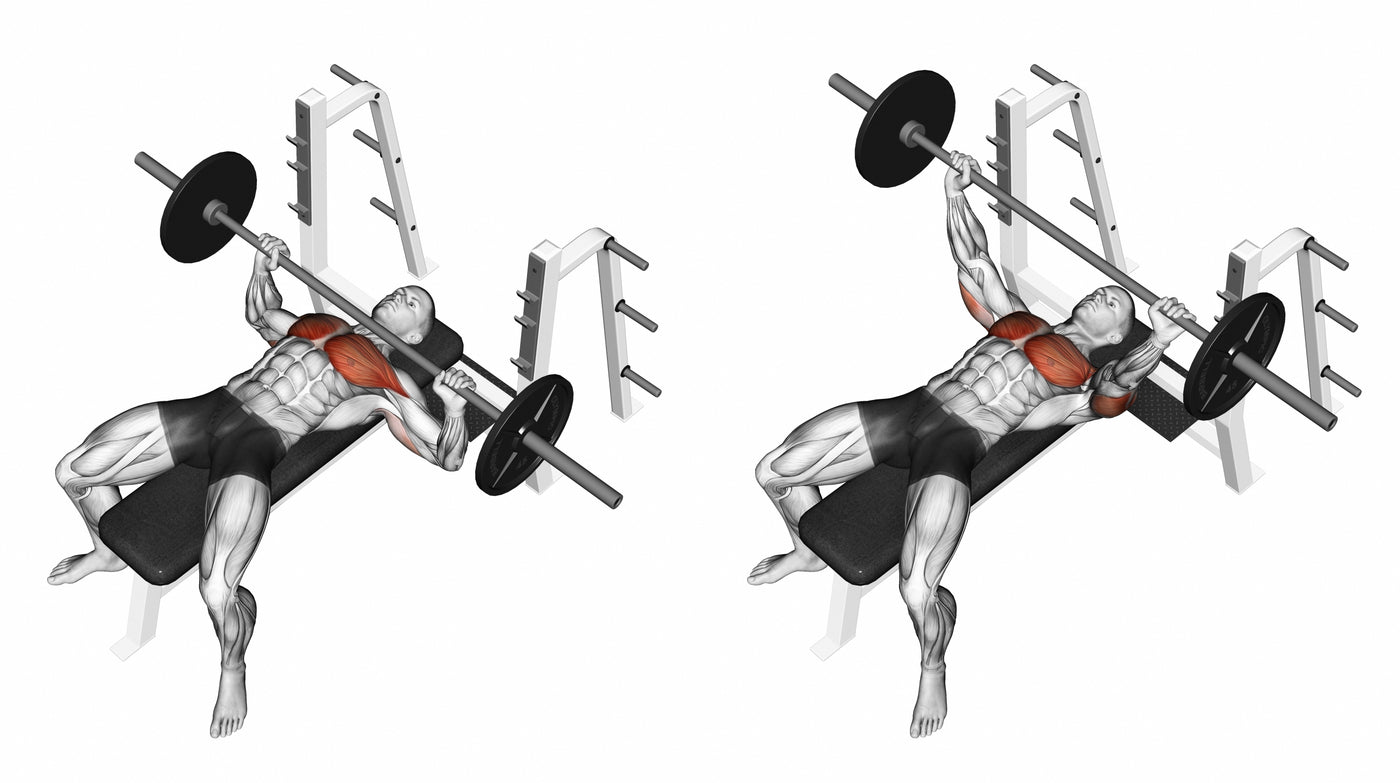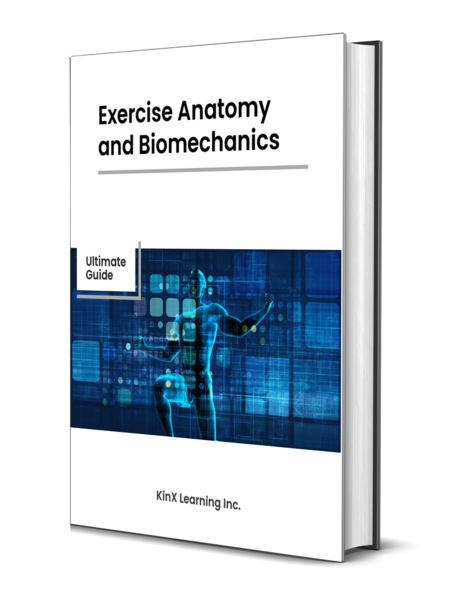Exercise Anatomy
Bench Press
The Bench Press is a fundamental compound exercise renowned for its ability to build upper body strength. A cornerstone in strength training, it engages multiple muscle groups simultaneously, focusing on the chest, shoulders, and triceps. Its simplicity hides its effectiveness; mastering this lift not only cultivates a powerful physique but also forms a crucial component of any comprehensive strength program. Embrace the bench press to unlock your upper body potential and witness the transformative impact it can have on your overall strength and muscle development.

Major Muscles and Actions Involved
The Bench Press, a quintessential upper-body strength exercise, primarily involves the joint action of elbow extension and shoulder flexion. In simple terms, it requires straightening the elbow joint and lifting the arms from a lowered to a raised position.
Muscles engaged in the Bench Press include the pectoralis major, deltoids (anterior), and triceps brachii. The pectoralis major, situated in the chest, is the primary muscle responsible for the horizontal adduction of the arms. The anterior deltoids assist in the initial phase of shoulder flexion, while the triceps brachii play a pivotal role in extending the elbow during the upward phase of the lift.
Executing the Bench Press effectively not only hones these muscle groups but also promotes overall upper body strength, making it a cornerstone exercise in resistance training.
Exercise Execution
To perform the Bench Press, begin by lying flat on a sturdy bench with your feet planted firmly on the ground. Ensure a natural arch in your lower back, and your shoulder blades should be retracted and pressed into the bench for stability.
Grasp the barbell with a grip slightly wider than shoulder-width apart. Your wrists should be straight, and the barbell should align with the midline of your chest.
Before lifting, take a deep breath and unrack the barbell, holding it directly above your chest with your arms fully extended. Lower the barbell slowly and under control until it lightly touches your chest, keeping your elbows at around a 90-degree angle.
Press the barbell back up to the starting position, exhaling as you exert force. Ensure a smooth, controlled movement throughout the entire range of motion. Focus on engaging your chest, shoulders, and triceps.
Maintain a stable body position throughout the exercise, with your back, head, and buttocks in contact with the bench. Avoid excessive arching of the back or bouncing the barbell off your chest.
Once you've completed the desired number of repetitions, carefully rack the barbell. It's crucial to start with a manageable weight, gradually increasing it as your strength improves. Always prioritize proper form to maximize the effectiveness of the Bench Press while minimizing the risk of injury.

Sports Uses
The Bench Press, a fundamental compound exercise, holds significant benefits across various sports activities, contributing to overall upper body strength and power. One notable sport where the Bench Press is of direct benefit is American football.
In football, particularly for positions like offensive and defensive linemen, a strong and forceful upper body is essential for blocking opponents, gaining leverage, and maintaining control on the field. The Bench Press, with its emphasis on chest, shoulder, and triceps strength, becomes a cornerstone exercise for football players looking to improve their performance in pushing and resisting opposing players during crucial plays.
Weightlifting is another area where the Bench Press plays a pivotal role. Powerlifting competitions, in particular, incorporate the Bench Press as one of the three main lifts. Athletes in powerlifting focus on maximizing their one-repetition maximum (1RM) in the Bench Press, showcasing raw upper body strength.
Additionally, the Bench Press benefits bodybuilding enthusiasts who aim to sculpt and develop their chest muscles. The exercise targets the pectoralis major, contributing to a well-defined and muscular chest appearance. Bodybuilders often incorporate various Bench Press variations into their training routines to add variety and address different angles of muscle engagement.
Moreover, sports like wrestling and rugby can benefit from the functional strength gained through the Bench Press. Wrestlers require upper body strength for grappling and controlling opponents, while rugby players need power for tackling and maintaining possession during physical encounters on the field.
Exercise Tips
- Technique: Maintain a stable body position by planting your feet firmly on the ground and keeping your back, head, and buttocks in contact with the bench throughout the movement. Focus on a controlled and smooth execution.
- Range of Motion: Aim for a full range of motion, lowering the barbell until it lightly touches your chest. Ensure your elbows form approximately a 90-degree angle at the bottom of the movement, allowing for proper muscle engagement.
- Amount of Weight Used: Start with a manageable weight, emphasizing proper form over heavy lifting. Gradually increase the weight as your strength improves to avoid compromising technique.
- Grip: Choose a grip slightly wider than shoulder-width, maintaining a firm but not excessively tight grip on the barbell. This grip width optimally targets the chest, shoulders, and triceps.
- Variations: Experiment with different variations, such as incline or decline Bench Press, to target muscles from varied angles. These variations contribute to overall chest development and muscle balance.
- Unique Muscle Involvement: Recognize the primary involvement of the pectoralis major, anterior deltoids, and triceps brachii. Focus on engaging these muscles throughout the movement for optimal strength gains.
- Breathing: Inhale deeply before lowering the barbell, and exhale forcefully as you press it back up. Maintain a consistent and controlled breathing pattern to enhance stability and power during the Bench Press.
- Spotter Assistance: When lifting heavy, always have a spotter for safety. A spotter can provide assistance if the weight becomes challenging and ensure a secure lift-off and rack.
Remember, the Bench Press is not just about moving weight; it's about executing the movement with precision to maximize muscle engagement and minimize the risk of injury. Prioritize proper form, gradually progress in weight, and incorporate variations to optimize your Bench Press performance.
BENCH PRESS VS THE PUSH-UP
Bench Press:
- Type of Exercise: Compound exercise targeting primarily the chest, shoulders, and triceps.
- Equipment: Typically performed on a flat bench with a barbell or dumbbells.
- Position: Lying on your back, you lift and lower weights toward and away from your chest.
- Intensity: Easily adjustable by adding or reducing weight on the barbell or dumbbells.
- Variations: Incline and decline bench press variations target different angles of the chest.
Push-Up:
- Type of Exercise: Bodyweight exercise engaging the chest, shoulders, triceps, and core.
- Equipment: No equipment needed; can be performed anywhere.
- Position: Starting in a plank position, you lower and lift your body by bending and straightening your arms.
- Intensity: Can be modified for different fitness levels (e.g., incline or knee push-ups).
- Variations: Wide grip, close grip, diamond push-ups, etc., offer variety and target muscles differently.
Considerations:
- Muscle Engagement: Both exercises work similar muscle groups but emphasize them differently.
- Stability: Push-ups require more core engagement for stability since they are performed on the ground.
- Accessibility: Push-ups are more accessible as they require no equipment and can be adapted for various fitness levels.
- Equipment Requirements: Bench press requires specific equipment, making it more suitable for gym settings.
Ultimately, the choice between the bench press and push-up depends on personal preferences, fitness goals, and available equipment. Each exercise has its unique benefits and can be incorporated into a well-rounded workout routine.

Want to Learn More?
Try our premium ebook, Exercise Anatomy and Biomechanics: Ultimate Guide.
Satisfaction guaranteed.
